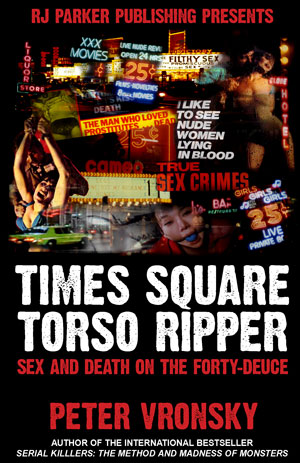The story of Richard Cottingham, the "Times Square
Ripper" or "Times Square Torso Killer", one of America's most sadistically
depraved serial killers.
A shocking case of unbridled sex, sadism, prostitution, porn, singles bars,
date-rape drugs, abduction, bondage, handcuffs, duct tape, torture,
sexploitation, perverted paraphilic fetishes, serial killing and
dismemberment on New York's notorious Times Square and the Forty-Deuce in
the 1970s.
Historian Peter Vronsky describes his brief encounter with serial killer
Cottingham in a seedy New York hotel in 1979 that later inspired him to
write his bestseller history “Serial Killers: The Method and Madness of
Monsters”. In “Times Square Torso Ripper” Vronsky explores the history of
the notorious Forty-Deuce strip on 42nd Street near Times Square and how it
spawned the sadistic monster Richard Cottingham in an era before the term
"serial killer" had been coined in popular culture.
Renowned serial homicide expert t
Dr. Robert D. Keppel said of Richard Cottingham, “I kept asking myself
what it was that ultimately intrigued me about the Cottingham case. Partly
it was the level of sadistic torture that Cottingham acted out on his
victims. He didn’t kill them and desecrate their bodies; he forced them to
experience pain and humiliation before he killed them. Then he desecrated
their bodies.”
Includes 50 photographs.
WARNING: THIS BOOK CONTAINS GRAPHIC FORENSIC CRIME SCENE
EVIDENCE PHOTOS, EXPLICIT LANGUANGE AND GRAPHIC DESCRIPTIONS OF EXTREME
SEXUAL VIOLENCE AND HOMICIDE THAT SOME MAY FIND OFFENSIVE AND HIGHLY
DISTURBING



